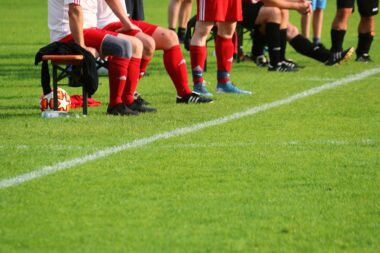The Science Behind Kabaddi Movements and Techniques
Kabaddi, an ancient sport with roots in India, demands a unique blend of fitness, strategy, and agility. The game is played between two teams, where one player attempts to touch opponents while holding his breath. Understanding the scientific principles behind Kabaddi enhances players’ performance by optimizing movements. Factors such as biomechanics, muscle memory, and agility play a crucial role. For instance, the art of raiding revolves around swift movements and quick reflexes. Players develop their skills through consistent practice, which enhances their muscle memory. This process allows them to execute complex maneuvers effortlessly, improving their chances of scoring. Moreover, coordination between team members enhances both offense and defense. Without precise techniques, a team may struggle against opponents. Additionally, the psychological aspect of the game, including mental toughness and strategic thinking, contributes to success. Kabaddi players must remain focused and calm under pressure while executing calculated risks. Combining physical conditioning with analytical strategies creates well-rounded players who can adapt to varying play styles, making them formidable opponents. A strong foundation in both the science and the skills of Kabaddi elevates the overall level of the game.
Key Movements in Kabaddi
The fundamental movements in Kabaddi are characterized by rapid acceleration, sudden deceleration, and quick changes of direction. These movements hinge on the principles of physics and are refined through rigorous training. For raiders, explosive sprinting is vital for gaining ground and surprising the defense. Players utilize techniques such as the ‘Dubki’ or ‘Jump’ to evade captures. Understanding the body’s mechanics enables players to optimize their movements, essential for evading defenders. On the defensive end, the ability to anticipate opponents’ moves can turn the tide of a match. Techniques emphasizing strong footwork, hand positions, and leverage create opportunities to successfully tackle. A defender’s body positioning, balance, and center of gravity are key. Coaches often employ drills that reinforce these critical movements, ensuring that players can perform under pressure. A well-structured training regimen focusing on agility and strength prepares players for game situations. Emphasis on flexibility and joint stability also aids in preventing injuries. Incorporating movement science into training reflects a modern approach that aids players in honing their techniques for superior performance during matches.
Another critical aspect of Kabaddi techniques is the importance of teamwork and communication among players. Effective communication facilitates coordinated attacks and defenses. Team members need to understand each other’s playing styles, strengths, and weaknesses, creating synergy on the court. Strategies are established before games, position assignments, and signals are crucial for real-time decision-making. Effective calls and signals enable quick adjustments during play, enhancing team cohesion. Moreover, successful teams often engage in regular practice sessions that focus on communication drills and strategies. Understanding each other’s nuances becomes essential for creating opportunities for scoring and preventing the opposition from gaining ground. Additionally, there is a need for trust among teammates. Players must rely on one another’s capabilities, which allows for fluid transitions during aggressive play. Likewise, periodic team debriefings help analyze game performance, allowing for improvements in strategy and execution. Team dynamics significantly influence outcomes; cohesive teams exhibit higher levels of collective confidence and morale. Thus, the intricacies of teamwork in Kabaddi cannot be underestimated. By fostering a collaborative environment, teams maximize their potential for success.
The Role of Fitness in Performance
Fitness is an unparalleled driving force behind success in Kabaddi, influencing every aspect of a player’s capability to perform. A balanced regimen encompassing strength training, cardiovascular endurance, flexibility, and agility is has proven to be very effective. Strength training improves muscle power, enabling players to execute tackles and evasive maneuvers effectively. Cardiovascular stamina allows players to maintain high energy levels throughout the match despite its demanding nature. Additionally, agility and speed drills enhance reflexes, crucial for rapid movements commonly observed during raids and attempts to tackle. Moreover, flexibility aids in injury prevention and recovery, ensuring players can perform at their peak without risking setbacks. Nutrition also plays a vital role in fitness, with dietary choices affecting energy levels and recovery processes. Coaches often focus on personalized nutrition plans that suit specific players based on needs and positions. Players are encouraged to hydrate adequately and consume a balanced diet rich in proteins, carbohydrates, and vitamins. A holistic approach to fitness that incorporates physical, nutritional, and mental elements ultimately durable Kabaddi players who consistently excel at their craft in both practice and competitions.
In addition to physical fitness, mental agility significantly influences Kabaddi performance levels. The sport requires constant strategic evaluation and flexibility in thought processes. Players must think on their feet, assessing opponent strategies while formulating counterplays. Mental toughness becomes pivotal during crucial moments in a match where decisions can lead to victory or defeat. Visualization techniques are often employed to enhance mental preparedness, where players envision successful outcomes through rehearsed scenarios. Likewise, focus training can minimize distractions during intense sequences of play. This psychological component of performance cannot be overlooked as fear or anxiety can severely impair gameplay. Coaches and sports psychologists work together to develop mental resilience amongst players through workshops and counseling sessions. Cultivating a positive mindset and effective coping strategies enhances overall team performance. However, while individual mental strength is crucial, fostering a supportive team atmosphere strengthens bonds among players. This synergy contributes to successful collaborations during matches, leading to higher win rates. Therefore, the importance of mental agility intertwined with physical capabilities creates a comprehensive framework for success in Kabaddi.
Dealing with Injuries
Injuries are an inherent risk in contact sports like Kabaddi, making injury prevention strategies essential. Awareness of common injuries, such as sprains, strains, and fractures, can guide players in maintaining their health. Players must familiarize themselves with proper techniques and body mechanics to limit injury sources. Regular physical assessments and conditioning can identify potential weaknesses before they evolve into severe injuries. Additionally, incorporating warm-up and cool-down routines into training is non-negotiable. These practices enhance physical preparedness and significantly reduce injury risks. Ice packs and compression techniques often play a crucial role in immediate injury management, allowing players to treat minor injuries effectively. Furthermore, strength and conditioning training strengthens the body in ways that promote resilience to injuries. However, when injuries occur, addressing recovery with seriousness is crucial. Players should seek immediate medical attention and follow a structured rehabilitation program. Patience during recovery times prevents further complications of recurring injuries. The significance of knowledge, prevention strategies, and recovery processes must be emphasized to maintain one’s longevity in Kabaddi. Players must continuously focus on self-care and get educated on best practices for injury management.
Kabaddi requires dedication, training, and a strong understanding of the science behind movements and techniques. Ultimately, players benefit immensely from systematically improving their physical capabilities and mental stamina. A data-driven approach to training that emphasizes biomechanics, injury prevention, and psychological resilience creates capable athletes. Various training methodologies serve as essential tools that refine specific skills, enhance teamwork, and foster communication. Incorporating these aspects requires commitment from both players and coaches. Moreover, the ethos of mutual respect and collaboration fosters a vibrant team culture, motivating players towards excellence. As Kabaddi continues to grow globally, its nuances will garner appreciation and analysis. Players are encouraged to embrace innovation in training techniques and strategies that further enhance their skills. The respect given to tradition must coexist with openness to new advancements, keeping the game dynamic and fresh. By understanding the scientific underpinnings of the sport, teams can create tactical advantages while ensuring players remain healthy, engaged, and motivated. Ultimately, the future of Kabaddi will thrive on the interplay of tradition, science, and teamwork, enriching the sport for generations.





